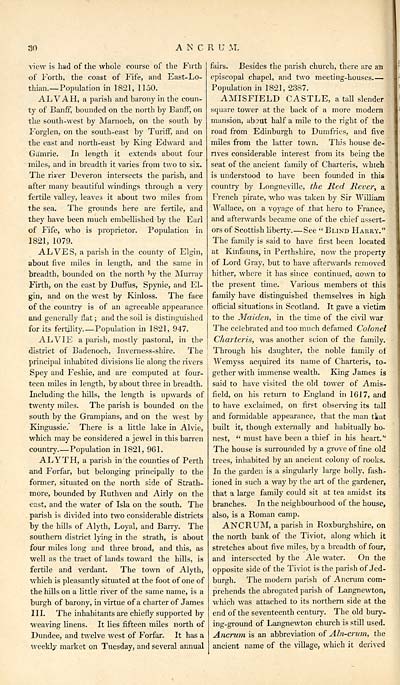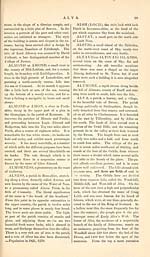Gazetteer of Scotland > Volume 1
(58) Page 30
Download files
Complete book:
Individual page:
Thumbnail gallery: Grid view | List view

30
A N C R U M.
-\iew is had of the whole course of the Firth
of Forth, the coast of Fife, and East-Lo-
thian. — Population in 1821, 1150.
AL V AH, a parish and barony in the coun-
ty of Banff, bounded on the north by Banff, on
the south-west by Marnoch, on the south by
Forglen, on the south-east by Turiff, and on
the east and north-east by King Edward and
Gamrie. In length it extends about four
miles, and in breadth it varies from two to six.
The river Deveron intersects the parish, and
after many beautiful windings through a very
fertile valley, leaves it about two miles from
the sea. The grounds here are fertile, and
they have been much embellished by the Earl
of Fife, who is proprietor. Population in
1821, 1079.
ALVES, a parish in the county of Elgin,
about five miles in length, and the same in
breadth, bounded on the north by the Murray
Firth, on the east by Duffus, Spynie, and El-
gin, and on the west by Kinloss. The face
of the country is of an agreeable appearance
and generally flat ; and the soil is distinguished
for its fertility— Population in 1821, 947.
ALVIE a parish, mostly pastoral, in the
district of Badenoch, Inverness-shire. The
principal inhabited divisions lie along the livers
Spey and Feshie, and are computed at four-
teen miles in length, by about three in breadth.
Including the hills, the length is upwards of
twenty miles. The parish is bounded on the
south by the Grampians, and on the west by
Kingussie. There is a little lake in Alvie,
which may be considered a jewel in this barren
country. — Population in 1821, 961.
ALYTH, a parish in the counties of Perth
and Forfar, but belonging principally to the
former, situated on the north side of Strath-
more, bounded by Ruthven and Airly on the
east, and the water of Isla on the south. The
parish is divided into two considerable districts
by the hills of Alyth, Loyal, and Barry. The
southern district lying in the strath, is about
four miles long and three broad, and this, as
well as the tract of lands toward the hills, is
fertile and verdant. The town of Alyth,
which is pleasantly situated at the foot of one of
the hills on a little river of the same name, is a
burgh of barony, in virtue of a charter of James
III. The inhabitants are chiefly supported by
weaving linens. It lies fifteen miles north of
Dundee, and twelve west of Forfar. It has a
weekly market on Tuesday, and several annual
fairs. Besides the parish church, there are all
episcopal chapel, and two meeting-houses. —
Population in 1821, 2387.
AMISFIELD CASTLE, a tall slender
square tower at the back of a more modern
mansion, about half a mile to the right of the
road from Edinburgh to Dumfries, and five
miles from the latter town. This house de-
rives considerable interest from its being the
seat of the ancient family of Charteris, which
is understood to have been founded in this
country by Longueville, the lied JRever, a
French pirate, who was taken by Sir William
Wallace, on a voyage of .that hero to France,
and afterwards became one of the chief assert-
ors of Scottish liberty. — See " Blind Haiiry."
The family is said to have first been located
at Kinfauns, in Perthshire, now the property
of Lord Gray, but to have afterwards removed
hither, where it has since continued, aown to
the present time. Various members of this
family have distinguished themselves in high
official situations in Scotland. It gave a victim
to the Maiden, in the time of the civil war.
The celebrated and too much defamed Colonel
Cltarteris, was another scion of the family.
Through his daughter, the noble family of
Wemyss acquired its name of Charteris, to-
gether with immense wealth. King James is
said to have visited the old tower of Amis-
field, on his return to England in 1617, and
to have exclaimed, on first observing its tall
and formidable appearance, that the man tfeat
built it, though externally and habitually ho-
nest, " must have been a thief in his heart."
The house is surrounded by a grove of fine old
trees, inhabited by an ancient colony of rooks.
In the garden is a singularly large holly, fash-
ioned in such a way by the ait of the gardener,
that a large family coidd sit at tea amidst its
branches. In the neighbourhood of the house,
also, is a Roman camp.
ANCRUM, a parish in Roxburghshire, on
the north bank of the Tiviot, along which it
stretches about five miles, by a breadth of four,
and intersected by the Ale water. On the
opposite side of the Tiviot is the parish of Jed-
burgh. The modern parish of Ancrum com-
prehends the abrogated parish of Langnewton,
which was attached to its northern side at the
end of the seventeenth century. The old bury-
ing-ground of Langnewton church is still used.
Ancrum is an abbreviation of Aln-crum, the
ancient name of the village, which it derived
A N C R U M.
-\iew is had of the whole course of the Firth
of Forth, the coast of Fife, and East-Lo-
thian. — Population in 1821, 1150.
AL V AH, a parish and barony in the coun-
ty of Banff, bounded on the north by Banff, on
the south-west by Marnoch, on the south by
Forglen, on the south-east by Turiff, and on
the east and north-east by King Edward and
Gamrie. In length it extends about four
miles, and in breadth it varies from two to six.
The river Deveron intersects the parish, and
after many beautiful windings through a very
fertile valley, leaves it about two miles from
the sea. The grounds here are fertile, and
they have been much embellished by the Earl
of Fife, who is proprietor. Population in
1821, 1079.
ALVES, a parish in the county of Elgin,
about five miles in length, and the same in
breadth, bounded on the north by the Murray
Firth, on the east by Duffus, Spynie, and El-
gin, and on the west by Kinloss. The face
of the country is of an agreeable appearance
and generally flat ; and the soil is distinguished
for its fertility— Population in 1821, 947.
ALVIE a parish, mostly pastoral, in the
district of Badenoch, Inverness-shire. The
principal inhabited divisions lie along the livers
Spey and Feshie, and are computed at four-
teen miles in length, by about three in breadth.
Including the hills, the length is upwards of
twenty miles. The parish is bounded on the
south by the Grampians, and on the west by
Kingussie. There is a little lake in Alvie,
which may be considered a jewel in this barren
country. — Population in 1821, 961.
ALYTH, a parish in the counties of Perth
and Forfar, but belonging principally to the
former, situated on the north side of Strath-
more, bounded by Ruthven and Airly on the
east, and the water of Isla on the south. The
parish is divided into two considerable districts
by the hills of Alyth, Loyal, and Barry. The
southern district lying in the strath, is about
four miles long and three broad, and this, as
well as the tract of lands toward the hills, is
fertile and verdant. The town of Alyth,
which is pleasantly situated at the foot of one of
the hills on a little river of the same name, is a
burgh of barony, in virtue of a charter of James
III. The inhabitants are chiefly supported by
weaving linens. It lies fifteen miles north of
Dundee, and twelve west of Forfar. It has a
weekly market on Tuesday, and several annual
fairs. Besides the parish church, there are all
episcopal chapel, and two meeting-houses. —
Population in 1821, 2387.
AMISFIELD CASTLE, a tall slender
square tower at the back of a more modern
mansion, about half a mile to the right of the
road from Edinburgh to Dumfries, and five
miles from the latter town. This house de-
rives considerable interest from its being the
seat of the ancient family of Charteris, which
is understood to have been founded in this
country by Longueville, the lied JRever, a
French pirate, who was taken by Sir William
Wallace, on a voyage of .that hero to France,
and afterwards became one of the chief assert-
ors of Scottish liberty. — See " Blind Haiiry."
The family is said to have first been located
at Kinfauns, in Perthshire, now the property
of Lord Gray, but to have afterwards removed
hither, where it has since continued, aown to
the present time. Various members of this
family have distinguished themselves in high
official situations in Scotland. It gave a victim
to the Maiden, in the time of the civil war.
The celebrated and too much defamed Colonel
Cltarteris, was another scion of the family.
Through his daughter, the noble family of
Wemyss acquired its name of Charteris, to-
gether with immense wealth. King James is
said to have visited the old tower of Amis-
field, on his return to England in 1617, and
to have exclaimed, on first observing its tall
and formidable appearance, that the man tfeat
built it, though externally and habitually ho-
nest, " must have been a thief in his heart."
The house is surrounded by a grove of fine old
trees, inhabited by an ancient colony of rooks.
In the garden is a singularly large holly, fash-
ioned in such a way by the ait of the gardener,
that a large family coidd sit at tea amidst its
branches. In the neighbourhood of the house,
also, is a Roman camp.
ANCRUM, a parish in Roxburghshire, on
the north bank of the Tiviot, along which it
stretches about five miles, by a breadth of four,
and intersected by the Ale water. On the
opposite side of the Tiviot is the parish of Jed-
burgh. The modern parish of Ancrum com-
prehends the abrogated parish of Langnewton,
which was attached to its northern side at the
end of the seventeenth century. The old bury-
ing-ground of Langnewton church is still used.
Ancrum is an abbreviation of Aln-crum, the
ancient name of the village, which it derived
Set display mode to: Large image | Transcription
Images and transcriptions on this page, including medium image downloads, may be used under the Creative Commons Attribution 4.0 International Licence unless otherwise stated. ![]()
| Gazetteers of Scotland, 1803-1901 > Gazetteer of Scotland > Volume 1 > (58) Page 30 |
|---|
| Permanent URL | https://digital.nls.uk/97425058 |
|---|
| Description | Volume I: Abbey to Glenartney. |
|---|---|
| Attribution and copyright: |
|
| Description | By Robert Chambers and William Chambers. Glasgow: Blackie & Son, 1838. 2 volumes. |
|---|---|
| Shelfmark | NF.1461.g.7 |
| Additional NLS resources: | |

